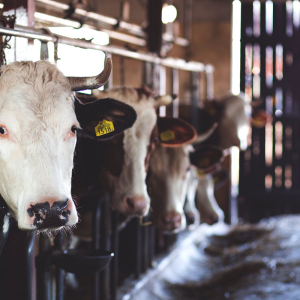
This paper calculates externalities - specifically, costs of climate change from greenhouse gas emissions - of categories of food produced in Germany. It finds that animal-based products (both conventional and organic) have the highest external climate costs (€2.41/kg product), followed by dairy products (€0.24/kg product for conventional and €0.19/kg product for organic), and finally plant-based products (€0.04/kg product for conventional and €0.02/kg product for organic).
The paper considers both broad food categories (plant-based, animal-based and dairy) and narrow categories (such as vegetables, legumes, eggs and pork).
Food production emissions for the year of 2016 are derived from the Global Emission Model of Integrated Systems. Land use change emissions (LUC) are calculated separately (using the methodology of Ponsioen and Blonk). LUC is calculated only for conventional production, where it is permitted to import fodder crops from other countries where the extent of arable land may be expanding. In organic production, this study assumes that LUC emissions do not arise, since most fodder has to come from either the same state or a neighbouring state within Germany and since the extent of arable land in Germany is currently decreasing.
Emissions of different greenhouse gases are aggregated using GWP100, i.e. 100-year CO2 equivalents. For a discussion of the differences between GWP100 and an alternative metric, GWP*, see the Table explainers Agricultural methane and its role as a greenhouse gas and Methane and the sustainability of ruminant livestock.
Emissions are converted to external climate costs using a value of €180 per ton of CO2 equivalent. This is the value used to represent climate costs by the German Federal Environment Agency (UBA). As the paper points out, emissions traded on the stock market do not necessarily have a price reflecting the damage done: traded carbon emissions had a cost of as low as ~€5/tonne during the study’s reference year (2016); at the time of writing (January 2020), they are ~€35/tonne.
As shown in the figure below, the paper finds that animal-based products have the highest absolute climate costs per kg, with plant-based products having the lowest.
Image: Figure 1, Pieper et al. Monetary costs [C] for broad categories (animal-based, dairy, plant-based in the comparison between conventional and organic production) arising from monetised externalities of greenhouse gas emissions. For conventional production (animal-based and dairy), the external costs from land-use change (LUC) emissions are highlighted separately.
The percentage price increase (see figure below) that would be required to reflect external climate costs in the price of each food category is higher for conventional production than organic production within each food category. Within each farming category (conventional or organic), animal-based products would require the highest percentage price increase, and plant-based products the lowest.
Image: Figure 2, Pieper et al. Relative percentage price [∆] increases for broad categories (animal-based, dairy, plant-based in the comparison between conventional and organic production) when externalities of greenhouse gas emissions are included in the producer’s price. For conventional production (animal-based and dairy), the surcharge from land-use change (LUC) emissions is highlighted separately.
Abstract
Although the agricultural sector is globally a main emitter of greenhouse gases, thorough economic analysis of environmental and social externalities has not yet been conducted. Available research assessing agricultural external costs lacks a differentiation between farming systems and food categories. A method addressing this scientific gap is established in this paper and applied in the context of Germany. Using life-cycle assessment and meta-analytical approaches, we calculate the external climate costs of foodstuff. Results show that external greenhouse gas costs are highest for conventional and organic animal-based products (2.41€/kg product; 146% and 71% surcharge on producer price level), followed by conventional dairy products (0.24€/kg product; 91% surcharge) and lowest for organic plant-based products (0.02€/kg product; 6% surcharge). The large difference of relative external climate costs between food categories as well as the absolute external climate costs of the agricultural sector imply the urgency for policy measures that close the gap between current market prices and the true costs of food.
Reference
Pieper, M., Michalke, A. and Gaugler, T., 2020. Calculation of external climate costs for food highlights inadequate pricing of animal products. Nature communications, 11(1), pp.1-13.
Read the full paper here. See also the Table explainer Food systems and greenhouse gas emissions, and the research library items Report by the Sustainable Food Trust estimates externalities of UK food consumption and Environmental costs and benefits of high-yield farming.







Post a new comment »